1867 Manuscript Letters NEW ZEALAND GOLD PROSPECTING West Coast Gold Rush
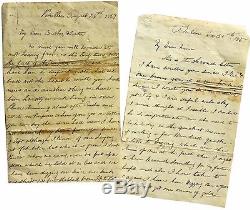
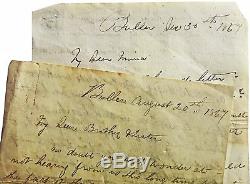
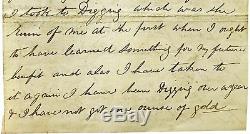
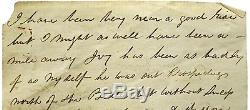



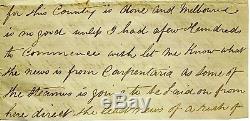
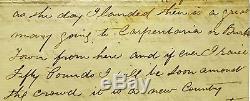


Rare books at fair prices... Asia - China & Japan.
Early New Zealand Gold Prospecting Manuscript Letters Rare Primary Source Account Of the West Coast Gold Rush Preceding the Great Migration 1867. Buller district [New Zealand], 1867. Two manuscript partial letters revealing the hardships and mercurial nature of gold prospecting, as the writer partakes in the West Coast Gold Rush. Two single leafs, each being two pages of a unique letter, each measuring approximately 11 x 18 cm. Both letters are lacking secondary leafs, some age-toning, otherwise in very good condition, and containing early primary source accounts of colonial New Zealand.
The writer is unidentified, though his letters reveal some details which might aid in further research. Previous to this mining expedition, he had lived in Melbourne, either owning or working as an employee at a shop. He set out for gold with another man, presumably a brother, who he refers to simply as Joey and who had also worked in a merchant shop prior to digging for gold.
He mentions "knocking about the Colonies" for 14 years, suggesting that he left Great Britain around 1853, but refers to himself as not old, suggesting that he may be in his mid-thirties or forties. Evidently, he was closely acquainted to James Ure Russell, a skilled sea captain and surveyor from Dunedin. James Ure Russell was a Master Mariner, who in 1867 suffered a bankruptcy. Captain James Ure Russell is listed as a marine surveyor, the 1884 volume of Stone's commercial, Municipal and General Directory... Cowan as recently married, this possibly being Elizabeth Jane Cowan, née Qualtrough, who in 1866 married William Andrew Cowan an immigrant from Ireland who fought in the Waikato war. The couple lived at Pakuranga near Auckland until at least 1870 when their son, the famous writer James Cowan was born. They subsequently settled in Kihikihi.New Zealand's West Coast was the second-richest gold-bearing area of New Zealand after Otago. The West Coast Gold Rush was in full force from 1864 to 1867, creating population in an area which had previously been visited by only a scant few Europeans. The letters are written at "Buller" on 20 August 1867 and 30 December 1867, respectively. During the period 1853 to 1876, Buller District was administered as part of the short-lived Nelson Province. Trying to remain hopeful, the gold prospector is on his second venture (at least), this time in the Buller Gorge located in the northwest of the South Island, as he writes of the challenges and the rapidly changing trends of gold fever , first to his brother and sister in Melbourne.
Having ventured out with a brother or friend named Joey, the two men excavated one shaft together, then worked separate spots not far apart, Joey trying proceeding north of the Buller. The writer and Joey pushed on, digging for a year, according to the letter of December 1867, to no avail. Joey contemplated becoming a sea merchant on a Sydney-California route, while the writer yearned to return to the recipient of the second letter, Mima Wilhemima?, possibly his wife, before making any firm decisions about future endeavours. The writer would have been panning for gold, as his adventure pre-dates the discovery of gold in quartz deposits in the region. In spite of his conclusion, ... The west coast is done... I must go make a fresh start in the world for this country is done...
In the hills east of Reefton and also at Lyell, in the Buller District, three years later in 1870, gold-bearing quartz lodes were discovered. Prior to this, only alluvial gold had been worked on the West Coast. This correspondence also pre-dates the Great Migration to New Zealand, which would begin four years later in 1871 and continue until 1885. The first wave of immigrants consisted of over 2700 labourers hired by the engineering firm of John Brogden and Sons to work on railway contracts.
British civilians typically had reservations of making the move, owing to the bad reputation of New Zealand's climate, its dangerous'natives' and the high costs and perils of the journey. The London office promoted widely with public speakers as well as recruiters who spoke directly to booksellers, grocers, schoolteachers, and the like. By 1873 there were 53 New Zealand government immigration agents in England, 78 in Scotland, and 46 in Ireland. We are, and have been so unfortunate... Hardly a week in one Place running about after Rushes and all to no Purpose...
Sunk one shaft 131 feet slabbed from Top to Bottom... We were over it 14 weeks... " "I did not think it possible I should have such bad luck... Since I left that shop in Melbourne... Joey is in a store at Fifty shillings per week Board and lodging, small wages for this Country but that is better than digging... Where one gets gold, 20 goes without it...I might never see Victoria again after 14 years knocking about the Colonies to be worse off or as bad as the day I landed... " " There is a great many going to Carpentaria or Burk Town from here and if ever I raise Fifty Pounds I will soon be amonst the crowd, it is a new Country... The fact of the matter is the west coast is done. The least of a rush of any sort excites the people here , you would not believe how many hard up people are on this coast but we must live in hope yet.
" " James Ure Russell seemed very anxious about Andrew. I told him you could not afford to keep him... His address is Ure c/o Grocus Princes St Dunedin. " "We are very unsettled, we don't know how long we may remain in one place, we are in good health. I took to digging and which was the ruin of me...Alas I have taken to it again, I have been Digging over a year & I have not got one ounce of gold. I have been very near a good rise but I might as well have been a mile away. " "Joey has been as badly off as myself, he was out Prospecting north of the Buller but without success... Went cutting firewood for a few days to make a Pound or two to take him to Hokiliki [Hokitika]... " "I will soon be after him...
But not before I see you again, if he gets a billit in Hokiliki at anything he will stop. " "I will Rise and Shine yet... Gold was found near the Taramakau River in 1864 by two Maori, Ihaia Tainui and Haimona Taukau. In 1865-66 gold was discovered at Okarito, Bruce Bay (the scene of the Hunt's Duffer gold rush), also around Charleston and along the Grey River. Miners became attracted to the West Coast following the prolific successes of the Central Otago Gold Rush and the Victoria Gold Rush, both having nearly finished yielding. By the end of 1864 there were an estimated 1800 prospectors on the West Coast, with many in the Hokitika area. The town of Hokitika was founded on gold mining in 1864, and by 1866 was the most populous settlement in all of New Zealand with over 25,000 inhabitants. In 1867 the rush began to decline, although gold mining continued on the Coast for some years. While many gold rush towns like Okarito, at one time the largest town on the Coast, and Charlestown, almost vanished when the miners moved on, in the three year period, principal towns were firmly established on the West coast.From'Gold Mining', from An Encyclopaedia of New Zealand, edited by A. McLintock, originally published in 1966.
The Nelson Province constituted in 1853 under the New Zealand Constitution Act 1852 and covered the entire upper South Island, including all of the present-day Buller , Kaikoura, Marlborough, Nelson, Tasman as well as the Grey District north of the Grey River and the Hurunui District north of the Hurunui River. It was abolished, along with all other provinces, in 1876.
The West Coast of Nelson Province was neglected and scarcely known for almost 20 years after the settlement of Tasman Bay. It first excited curiosity late in 1859 when small samples of alluvial gold were discovered in the Buller Gorge by a survey party under J. Vigorous exploratory activity followed in 1860 when provincial government parties were sent to find routeways, map the Buller coalfield, report on timber and mineral resources, and examine potential sites for settlement.
A few miners from Golden Bay came by sea to the Buller in 1861 and won small quantities of gold from the river beaches , while in 1863 the open country in the central Grey Valley was taken up in three pastoral runs. The main inrush of the mining population took place in the extreme south of the province in July 1865 when diggers crossed from what were then the west Canterbury goldfields, spread up the Grey Valley and its numerous tributary creeks, and within 12 months were prospecting in the Inangahua Valley. In the spring of 1866 a large rush occurred to the terraces and beaches of the Buller coast plain. Three bustling mining camps, Charleston, Brighton, and Addisons, each of more than 1,000 people, sprang up within a few months. Charleston, with 1,800 people at the 1867 census, was then the second largest urban centre in Nelson Province.
Until 1870 only alluvial gold had been worked on the West Coast but in that year gold-bearing quartz lodes were discovered in the hills east of Reefton and at Lyell. A steady flow of population set in to the Reefton district from the declining alluvial diggings and, despite great difficulties presented by the terrain and bush cover, machinery was established on the lodes by 1873. Quartz mining was a more stable basis for settlement than alluvial gold working. The item "1867 Manuscript Letters NEW ZEALAND GOLD PROSPECTING West Coast Gold Rush" is in sale since Tuesday, November 28, 2017.
This item is in the category "Collectibles\Paper\Documents\1800-1899". The seller is "voyagerpress" and is located in Blaine, Washington. This item can be shipped worldwide.

